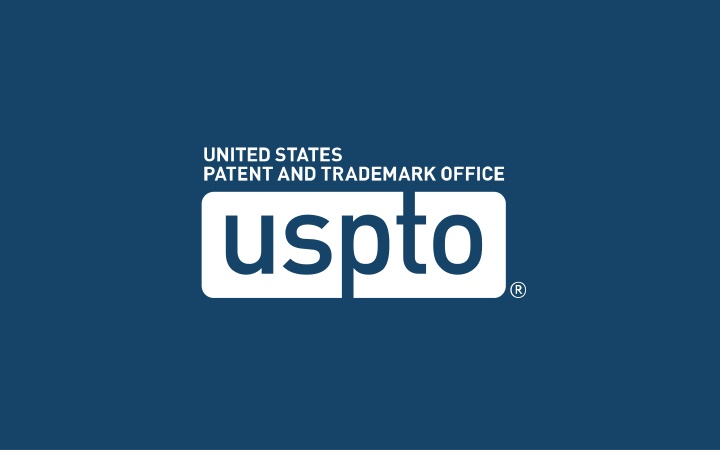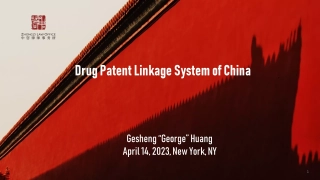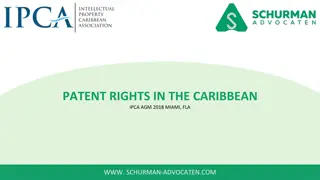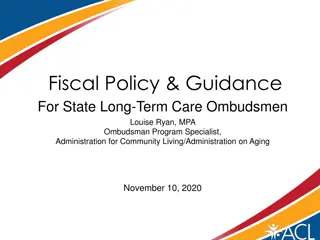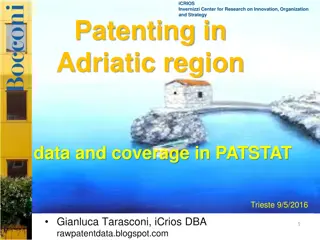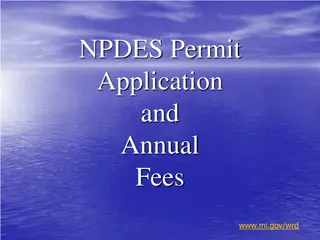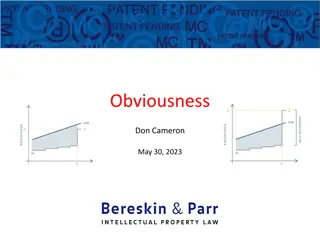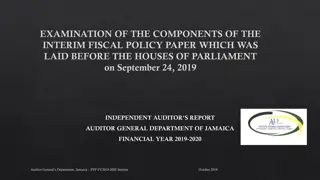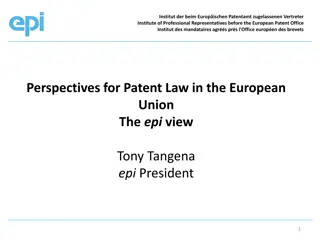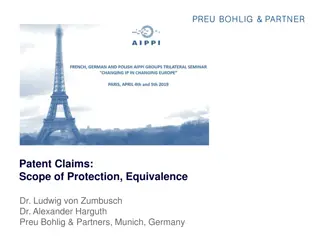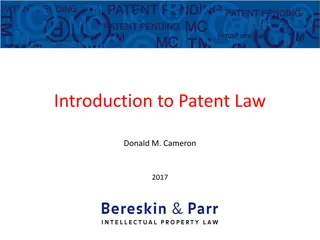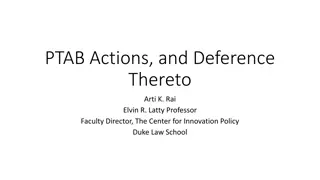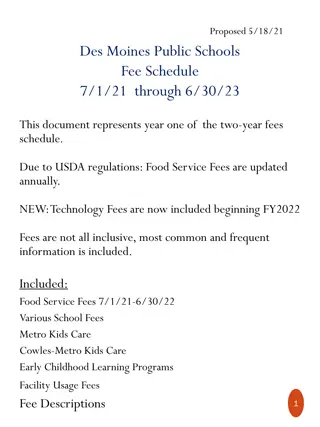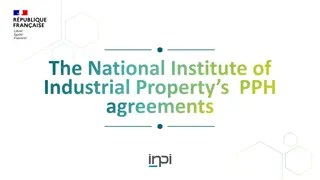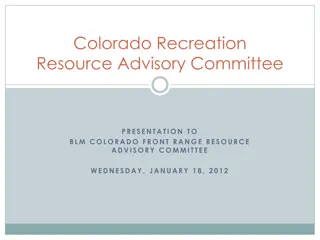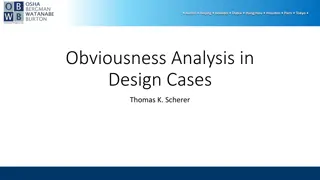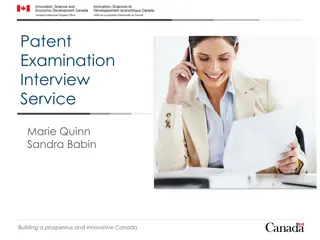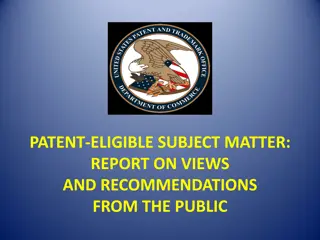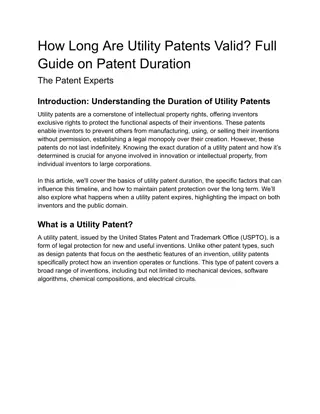Setting and Adjusting Patent Fees for Fiscal Year 2025
The United States Patent and Trademark Office (USPTO) is proposing adjustments to patent fees to ensure sustainable funding, efficient operations, and access to the patent system. The Notice of Proposed Rulemaking outlines the objectives and goals for fee setting during FY 2025, aiming to recover costs, promote financial sustainability, and align fees with services provided.
Download Presentation

Please find below an Image/Link to download the presentation.
The content on the website is provided AS IS for your information and personal use only. It may not be sold, licensed, or shared on other websites without obtaining consent from the author.If you encounter any issues during the download, it is possible that the publisher has removed the file from their server.
You are allowed to download the files provided on this website for personal or commercial use, subject to the condition that they are used lawfully. All files are the property of their respective owners.
The content on the website is provided AS IS for your information and personal use only. It may not be sold, licensed, or shared on other websites without obtaining consent from the author.
E N D
Presentation Transcript
Notice of Proposed Rulemaking: At-a-Glance Setting and Adjusting Patent Fees during Fiscal Year 2025
Overview As authorized by Section 10 of the Leahy-Smith America Invents Act (AIA)1, the United States Patent and Trademark Office (USPTO) prepared a notice of proposed rulemaking (NPRM) to set or adjust patent fees to: Ensure aggregate revenue to recovers the aggregate costs of patent operations in future years (based on current projections) Maintain operations and continue progress towards achieving strategic goals The NPRM, Setting and Adjusting Patent Fees During FY 2025 includes targeted adjustments, an across-the-board fee adjustment, and a separate adjustment to front-end patent fees On April 20, 2023, the Director notified the Patent Public Advisory Committee (PPAC) of the USPTO s intent to set or adjust patent fees and submitted a preliminary patent fee proposal On May 18, 2023, the PPAC held a public hearing in Alexandria, Virginia The PPAC prepared a report (incorporating input from the public) with their comments, advice, and recommendations and the USPTO considered and analyzed the information contained in the report before publishing this NPRM. Based on the feedback from the public and the PPAC, the USPTO: Will not pursue the proposals for electronically submitted assignments and additional words in an inter partes or post-grant petition Modified the continuing applications proposal to extend timing thresholds This NPRM starts the 60-day period for members of the public to provide additional comments to the USPTO The USPTO intends to issue a final rule in FY 2025 following a review of comments received during the public comment period 3 1As amended by the Study of Underrepresented Classes Chasing Engineering and Science Success Act of 2018 (SUCCESS Act).
Fee setting goals and objectives The goal of fee setting at the USPTO is to provide sufficient financial resources to facilitate the effective administration of the United States intellectual property (IP) system The overriding principles behind this goal are to: Operate within a sustainable funding model that avoids disruptions caused by fluctuations in financial operations Enable the USPTO to continue making strategic improvements The fee setting objectives of the NPRM, Setting and Adjusting Patent Fees During FY 2025 are: Recover aggregate costs to finance the USPTO s mission, strategic goals, and priorities Enable financial sustainability Promote efficient operations and filing behaviors Better align fees with the costs of services provided Encourage access to the patent system for all stakeholders 4
Fee setting goals and objectives (cont.) The fee proposals detailed in the NPRM, Setting and Adjusting Patent Fees during Fiscal Year 2025 , directly aligned to: The fee structure philosophy, including the following fee setting policy factors: Promote innovation strategies Align fees with the full cost of products and services Facilitate the effective administration of the patent system Offer application processing options The Strategic Plan goals: Goal 1: Drive inclusive U.S. innovation and global competitiveness Goal 2: Promote the efficient delivery of reliable IP rights Goal 3: Promote the protection of IP against new and persistent threats Goal 4: Bring innovation to impact for the public good Goal 5: Generate impactful employee and customer experiences by maximizing agency operations 5
Benefits for IP stakeholders Enhance the United States role as a global innovation leader Promote inclusive innovation through active engagement and widespread access to IP resources and tools Foster an innovation mindset in more Americans Issue and maintain robust and reliable patents that incentivize and protect innovation Improve patent application pendency Optimize patent application processes to enable efficiencies for applicants and other stakeholders Protect patents from fraudulent and abusive behaviors Support the development and enforcement of clear IP laws Help those pursuing IP protection to identify available funding sources Continue to equitably deliver exceptional customer experiences Develop modern information technology (IT) infrastructure and applications 6
Proposed patent fee changes The USPTO proposes to set or adjust fees contained in the table of proposed fee adjustments. The changes impact the following fee categories: After-final consideration 2.0 pilot program Continuing applications Design applications Excess claims Extensions of time for provisional applications Information disclosure statements Patent term adjustment Patent term extension Requests for continued examination Suspensions of action Terminal disclaimers Unintentional delay petitions America Invents Act trial fees Director review of Patent Trial and Appeal Board (PTAB) decision Across-the-board adjustments to all other fees 7
After-Final Consideration Pilot (AFCP 2.0) Propose a new fee for participating in the existing AFCP 2.0 Program, in which applicants may submit certain papers for consideration after final action without filing a request for continued examination (RCE) or continued prosecution application (CPA). The fee will improve cost recovery. Around 60,000 requests for AFCP 2.0 were filed in FY 2022, representing more than 10% of disposals. More than half of AFCP 2.0 filings resulted in an examiner interview and more than 100,000 hours of patent examiner time were charged to AFCP 2.0 in FY 2022, resulting in costs of more than $15 million to the USPTO. In addition to the $15 million, other costs include the cost for examiners to initially consider AFCP 2.0 requests and any consultation costs with supervisors and primary examiners. These costs represent time that could otherwise be used to examine new applications. By charging this fee, the USPTO will be able to continue providing the AFCP 2.0 option to applicants. Historical cost (FY 2022) Current fee* Proposed fee* Dollar change Percent change Fee code Description New fee code n/a n/a n/a Consideration of AFCP 2.0 request $500 n/a * Undiscounted fee rate 9
Continuing applications Propose a new tiered fee for filing continuing applications more than five or eight years after the earliest benefit date, or presenting delayed benefit claims that would achieve the same effect. These fees would affect about 27% of continuing applications. About 16% of continuing applications fall into the first tier (over 22,000 per year). About 11% of continuing applications fall into the second tier (over 15,000 per year). Because maintenance fees are based on the issue date, while the patent term is based on the earliest benefit date, these affected applications have less term remaining at issue (if granted), and this, therefore, reduces potential future maintenance fees that eventually recover the examination costs incurred for these applications. The proposed fee would partially offset foregone maintenance fee revenue resulting from later-filed continuing applications. The proposed fee would recover the front-end costs of continuing-type applications with extended benefit claim practice and encourage more efficient filing and prosecution behavior from applicants. Historical cost (FY 2022) Filing an application or presentation of benefit claim more than five years after earliest benefit date Filing an application or presentation of benefit claim more than eight years after earliest benefit date Current fee* Proposed fee* Dollar change Percent change Fee code Description New fee code n/a n/a $2,200 n/a n/a New fee code n/a n/a $3,500 n/a n/a 10 * Undiscounted fee rate
Design applications Propose increasing fees for filing, search, examination, and issuance of design applications. Current fee rates do not recover the cost of examination of design patents, for discounted or undiscounted entities. Rapid growth in applications among micro entities (mostly foreign) has compounded this shortfall. In FY 2023, about 28% of design filings paid micro entity fee rates, up from just 10% in FY 2014. Design patentees do not pay maintenance fees; any shortfall must be subsidized by utility collections. With the current number of small and micro entity applicants, about 61% of design costs are subsidized by utility collections. Targeted design fee increases will recover a higher percentage, but not all, of the costs from design applicants and reduce subsidization from other fee sources. (see table on next page) 11
Design patents(cont.) Historical cost (FY 2022) Current fee* Proposed fee* Dollar change Percent change Fee code Description 1012 Basic filing fee Design $250 $220 $300 $80 36% 1017 Basic filing fee Design CPA $930 $220 $300 $80 36% 1112 Design search fee or Design CPA search fee $574 $160 $300 $140 88% Design examination fee or Design CPA examination fee 1312 $835 $640 $700 $60 9% 1502 Design issue fee $574 $740 $1,300 $560 76% International design application first part U.S. designation fee 1791 n/a $1,020 $1,300 $280 27% (Part II Designation Fee) Issue fee paid through the International Bureau in an international design application 1792 n/a $740 $1,300 $560 76% * Undiscounted fee rate 12
Excess claims Propose increasing fees for presenting claims in excess of the statutory thresholds. Better alignment with the cost of examining an application with excess claims. Encourages applicants to be more efficient in the number of claims filed. Continuing application and excess claim fees are naturally linked to each other such that they are likely to have counter-balancing effects. An increase in excess claims fees is needed to prevent a potential substitution scenario where applicants avoid the continuing application fee by filing more excess claims. Historical cost (FY 2022) Current fee* Proposed fee* Dollar change Percent change Fee code Description 1202 Each claim in excess of 20 n/a $100 $200 $100 100% 1201 Each independent claim in excess of three n/a $480 $600 $120 25% * Undiscounted fee rate 13
Extension of time (EOT) for provisional applications Propose decreasing EOT fees in provisional applications. Provisional applications are not examined; therefore, it is not urgent to expedite processing. Reduces the financial burden on applicants who are still determining whether to move forward with a nonprovisional application. Reduces the financial burden on micro entity filers, who are disproportionally affected by EOT fees in provisional applications. Between 2014 and 2021, micro entities paid over 36% of EOT fees in provisional applications while filing only 17% of applications. Micro entity applicants may accrue EOT fees for no other reason than trying to formally establish micro entity status due to signature errors or omissions. Aligns with our objective to foster inclusive innovation and increase access to the patent system. (see table on next page) 14
Extension of time (EOT) for provisional applications (cont.) Historical cost (FY 2022) Current fee* Proposed fee* Dollar change Percent change Fee code Description New fee code Extension for response within first month, provisional application n/a $220 $50 - $170 -77% New fee code Extension for response within second month, provisional application n/a $640 $100 - $540 -84% New fee code Extension for response within third month, provisional application n/a $1,480 $200 - $1,280 -86% New fee code Extension for response within fourth month, provisional application n/a $2,320 $400 - $1,920 -83% New fee code Extension for response within fifth month, provisional application n/a $3,160 $800 - $2,360 -75% * Undiscounted fee rate 15
Information disclosure statement (IDS) Propose a separate surcharge based on the cumulative number of applicant citations listed in an application. Better reflects the additional costs and time provided to examiners to consider these large IDS submissions. The USPTO receives a large number of cited references on IDS submissions, sometimes in the thousands, for a small percentage of applications. Large IDS submissions negatively impact prosecution time and burden examiners. These applications have a higher cost because the USPTO provides examiners extra time to review large IDS submissions. Encourages more efficient filing and prosecution behavior from applicants. The three proposed thresholds are: 50 references: about 13% of applications currently exceed this threshold 100 references: about 8% of applications currently exceed this threshold 200 references: about 4% of applications currently exceed this threshold (see table on next page) 16
Information disclosure statement (IDS) (cont.) Historical cost (FY 2022) Current fee Proposed fee Dollar change Percent change Fee code Description Filing an information disclosure statement that causes the cumulative number of applicant-provided items of information to exceed 50 but not exceed 100 New fee code n/a n/a $200 n/a n/a Filing an information disclosure statement that causes the cumulative number of applicant-provided items of information to exceed 100 but not exceed 200 $500, less any amount previously New fee code n/a n/a n/a n/a paid $800, less Filing an information disclosure statement that causes the cumulative number of applicant-provided items of information to exceed 200 any New fee code n/a n/a amounts previously n/a n/a paid Discounted fees not available 17
Patent term adjustment (PTA) Propose increasing the fee for patentees requesting reconsideration of their PTA indicated on the patent. Improves recovery of the costs the USPTO incurs to reconsider the PTA. Distributes the costs of the service to only those applicants requesting the service. The USPTO considers about 500 requests per year (0.15% of issued patents). Applicants can reduce their use of this service by checking the accuracy of data entered in the One Patent Service Gateway (OPSG) system in Patent Center regarding their applications throughout the examination process and notifying the USPTO of errors before allowance. Historical cost (FY 2022) Current fee Proposed fee Dollar change Percent change Fee code Description Filing an application for patent term adjustment 1455 $745 $210 $300 $90 43% Discounted fees not available 18
Patent term extension (PTE) Propose increasing the fees for patentees seeking to extend the patent term under 35 U.S.C. 156 in conjunction with the Food and Drug Administration/U.S. Department of Agriculture approval process. Current fees cover only a small percentage of the costs of reviewing a PTE application, which is a complex and lengthy process. Distributes the costs of the service to only those applicants (approximately 100 per year) requesting the service. Propose creating a supplemental redetermination fee for patentees who choose to disclaim patent term late in the PTE process. Supplemental redeterminations require the USPTO to recalculate the PTE determination, which is costly. Encourages patentees to disclaim patent term earlier in the PTE process, improving USPTO efficiency. While the proposed fee amount for the application for extension of term of patent is greater than the reported unit cost, the additional collections will be used to fund other statutorily-required extension-related services that do not have a separate fee or that are not fully-funded by the existing fees. (see table on next page) 19
Patent term extension (PTE) (cont.) Historical cost (FY 2022) Current fee Proposed fee Dollar change Percent change Fee code Description 1457 Application for extension of term of patent $2,581 $1,180 $6,700 $5,520 468% 1458 Initial application for interim extension $2,347 $440 $1,320 $880 200% 1459 Subsequent application for interim extension $2,347 $230 $680 $450 196% New fee code Supplemental redetermination after notice of final determination n/a n/a $1,440 $1,440 n/a Discounted fees not available 20
Request for continued examination (RCE) Propose increasing fees for a first RCE by 10% and splitting the current fee for second and subsequent RCEs into an increased fee for a second RCE and a new, higher fee for a third and subsequent RCE. Proposed fees for multiple RCEs allow the costs of continued examinations to be recovered directly from those applicants requesting multiple RCEs, instead of relying on other fees to subsidize the costs. The proposal continues to set the first RCE fee below cost. Encourages applicants to be more efficient when considering filing multiple RCE requests. About 9% of RCEs filed are for third and subsequent RCEs. Delays in prosecution resulting from multiple RCEs may reduce the potential for future maintenance fees that eventually recover the examination costs incurred for these applications. Balances RCEs as a path to allowance with other after-final options to provide efficient and effective paths to final disposal. (see table on next page) 21
Request for continued examination (RCE) (cont.) Historical cost (FY 2022) Current fee* Proposed fee* Dollar change Percent change Fee code Description Request for continued examination (RCE) first request 1801 $3,059 $140 10% $1,360 $1,500 Request for continued examination (RCE) second request 1820 $2,191 $500 25% $2,000 $2,500 Request for continued examination (RCE) third and subsequent request New fee code $2,169 $1,600 80% $2,000 $3,600 * Undiscounted fee rate 22
Suspension of action Propose removing fees for suspensions of action under 37 CFR 1.103(a) from the broad category described in 37 CFR 1.17(g) and creating a tiered system in which the fees for subsequent suspensions are charged at a higher rate. Would not affect fees for suspensions of action requested at the time of filing a CPA or RCE. Encourages efficient applicant behavior and promotes efficient examination. Would not significantly impact patent applications for small and micro entities. The USPTO receives approximately 2,500 requests each year. Of those requests, 86% are by undiscounted entities, 12% by small entities, and 2% by micro entities. Historical cost (FY 2022) Current fee* Proposed fee* Dollar change Percent change Fee code Description New fee code First request for suspension of action n/a $220 $300 $80 36% New fee code Subsequent request for suspension of action n/a $220 $450 $230 105% * Undiscounted fee rate 23
Terminal disclaimer Propose separating the terminal disclaimer fee from the statutory disclaimer fee and charging a sliding scale of fees for filing a terminal disclaimer, based on when it is filed. The cost to process a terminal disclaimer increases greatly after certain milestones, such as final action or appeal. Over 63,000 terminal disclaimers are filed annually, over 90% of which are filed after the first action on the merits, with over 28% filed after final rejection, on appeal, or after allowance. The sliding scale fee increases are designed to: Encourage applicants to file a terminal disclaimer as early as possible during the examination process; Encourage applicants to promptly address double patenting issues that arise during prosecution; Promote efficient patent examination by reducing unnecessary costs; and Provide greater certainty for the public by providing earlier notice of when the patent term will end. (see table on next page) 24
Terminal disclaimer (cont.) Historical cost (FY 2022) Proposed fee Dollar change Percent change Fee code Description Current fee Terminal disclaimer, filed prior to the first action on the merits New fee code n/a $30 18% $170 $200 Terminal disclaimer, filed prior to a final action or allowance New fee code n/a $330 194% $170 $500 Terminal disclaimer, filed after final or allowance New fee code n/a $630 371% $170 $800 Terminal disclaimer, filed on or after a notice of appeal New fee code n/a $930 547% $170 $1,100 Terminal disclaimer, filed in a patented case or in an application for reissue New fee code n/a $1,230 724% $170 $1,400 Discounted fees not available 25
Unintentional delay petitions Propose increasing the fee for petitions based on unintentional delay and creating a higher tier for unintentional delay petitions for delays of more than two years. Fee increase for petitions with a delay less than or equal to two years is designed to offset the rising costs of new procedures. Under new procedures established in March 2020, petitions based on unintentional delay for a period of more than two years require the petitioner to provide additional information, receive higher scrutiny, and go through a more rigorous review by the petitions attorneys. As a result, existing fees for unintentional delay petitions no longer recover the costs for evaluating and deciding these petitions. (continued on next page) 26
Unintentional delay petitions (cont.) Creation of a higher tier aligns with increased costs to the USPTO when deciding a petition with a longer delay. The USPTO receives approximately 12,000 unintentional delay petitions each year. Only about 10% of unintentional delay petitions have a delay of more than two years and would incur the higher cost. Historical cost (FY 2022) Current fee* Proposed fee* Dollar change Percent change Fee code Description 1454/1558/ 1784 Unintentional delay less than or equal to two years n/a $2,100 $2,200 $100 5% New fee codes Unintentional delay greater than two years n/a $2,100 $3,000 $900 43% * Undiscounted fee rate 27
America Invents Act (AIA) trial fees Propose increasing AIA trial fees by 25%. The costs associated with IPR have continued to increase as a result of recent court cases and higher operating costs caused, in part, by inflation. These fee increases support aggregate cost recovery for USPTO operations. (see table on next page) 29
AIA trial fees (cont.) Historical cost (FY 2022) Proposed fee Dollar change Percent change Fee code Description Current fee Inter partes review request fee up to 20 claims $21,980 1406 $19,000 $23,750 $4,750 25% Inter partes review post-institution fee up to 20 claims $37,563 1414 $22,500 $28,125 $5,625 25% Inter partes review request of each claim in excess of 20 n/a $470 $95 1407 $375 25% Inter partes post-institution request of each claim in excess of 20 Post-grant or covered business method review request fee up to 20 claims n/a 1415 $750 $940 $190 25% $37,683 $20,000 $25,000 $5,000 1408 25% Post-grant or covered business method review post-institution fee up to 20 claims $49,198 $27,500 $34,375 $6,875 1416 25% Post-grant or covered business method review request of each claim in excess of 20 n/a 1409 $475 $595 $120 25% Post-grant or covered business method review post-institution request of each claim in excess of 20 n/a 1417 $1,050 $1,315 $265 25% Discounted fees not available 30
Director review of a PTAB decision Propose a new fee for parties requesting review of a PTAB decision by the Director. Fee is for the review process established by the USPTO in response to the Arthrex decision. When granted, various USPTO personnel assist the Director in case processing and in issuing and publicizing the decision. Given the number of personnel involved, the cost borne by the USPTO are expected to be significantly higher than the proposed fee. Proposal is set to match the Petitions to the Chief Administrative Judge fee. Historical cost (FY 2022) Current fee Proposed fee Dollar change Percent change Fee code Description New fee code Request for review of a PTAB decision by the Director n/a n/a $440 n/a n/a Discounted fees not available 31
Across-the-board inflationary adjustment Propose increasing patent and PTAB fees not covered by targeted adjustments by approximately 5%. Additional revenue generated from proposed increases will: ensure that aggregate revenue recovers aggregate costs to achieve the mission, and advance policies and activities that provide robust and reliable patents and enhance the country s innovation ecosystem. 33
Across-the-board example Utility patents, maintenance Current and proposed undiscounted maintenance fees $16,000 $14,135 $13,460 $14,000 $12,000 $8,085 $10,000 Fee amount ($) $7,700 3rd stage $8,000 2nd stage $6,000 1st stage $3,950 $4,000 $3,760 $2,000 $2,100 $2,000 $0 Current Proposed 34
Front-end fee proposal Propose increasing filing, search, and examination fees by an additional 5% on top of the 5% across-the-board proposal (10% in total). To mitigate barriers to entry into the IP system, filing, search, and examination fees are lower than the costs incurred by the USPTO in performing those services. Aggregate shortfalls are recovered through other fee collections, primarily maintenance fees, which are collected later in the patent life cycle. This proposal marginally recovers some additional filing, search, and examination costs earlier in the patent life cycle, but not all associated costs with those activities, thus remaining consistent with a low barrier to entry policy. 35
Front-end fee proposal example Utility filing, search, and examination fees Current and proposed undiscounted fees for utility filing, search, and examination $2,500 $2,000 $2,000 $1,820 Fee amount ($) $880 $1,500 $800 Exam Search Filing $1,000 $770 $700 $500 $350 $320 $0 Current Proposed 36
Basic utility patent life cycle fees for undiscounted entities Current and proposed Cumulative fees, current Cumulative fees, proposed Cumulative fees, percent change Description Current fee Proposed fee Filing $320 $320 $350 $350 9% Search $700 $1,020 $770 $1,120 10% Examination $800 $1,820 $880 $2,000 10% Issue $1,200 $3,020 $1,260 $3,260 8% 1st stage maintenance $2,000 $5,020 $2,100 $5,360 7% 2nd stage maintenance $3,760 $8,780 $3,950 $9,310 6% 3rd stage maintenance $7,700 $16,480 $8,085 $17,395 6% 37
Analysis of alternatives As part of the rulemaking process, the USPTO conducted two alternative analyses: Initial Regulatory Flexibility Analysis (IRFA). Regulatory Impact Analysis (RIA). The USPTO s rulemaking strategies and goals are comprised of strategic priorities (goals, objectives, and initiatives) from the Strategic Plan and fee setting policy factors. Four alternatives were analyzed for alignment with the rulemaking strategies and goals: Proposed fee schedule included in the NPRM, Unit cost recovery setting most individual undiscounted fees at the historical cost of performing the service, Across the board adjustment that set fees by applying a one-time 12.5%, across-the-board inflationary increase to the current fee schedule, and Baseline (current fee schedule). 39
Analysis of alternatives (cont.) The IRFA finds that the proposed fee schedule does not impose undue or disproportionate burdens on smaller entities. The RIA concludes that the overall qualitative benefits to patent applicants, patent holders, other patent stakeholders, and society of the proposed fee schedule are significant, specifically those benefits related to the targeted fee schedule design changes. Both analyses find that: Patent applicants and holders can expect progress towards optimizing patent application pendency and examination timeframes; Issuing highly reliable patents; Fostering innovation through business effectiveness; Enhancing the operations of PTAB; Optimizing speed, quality, and cost-effectiveness of IT delivery to delivery to achieve business value; and Ensuring financial sustainability to facilitate effective patent operations. 40
